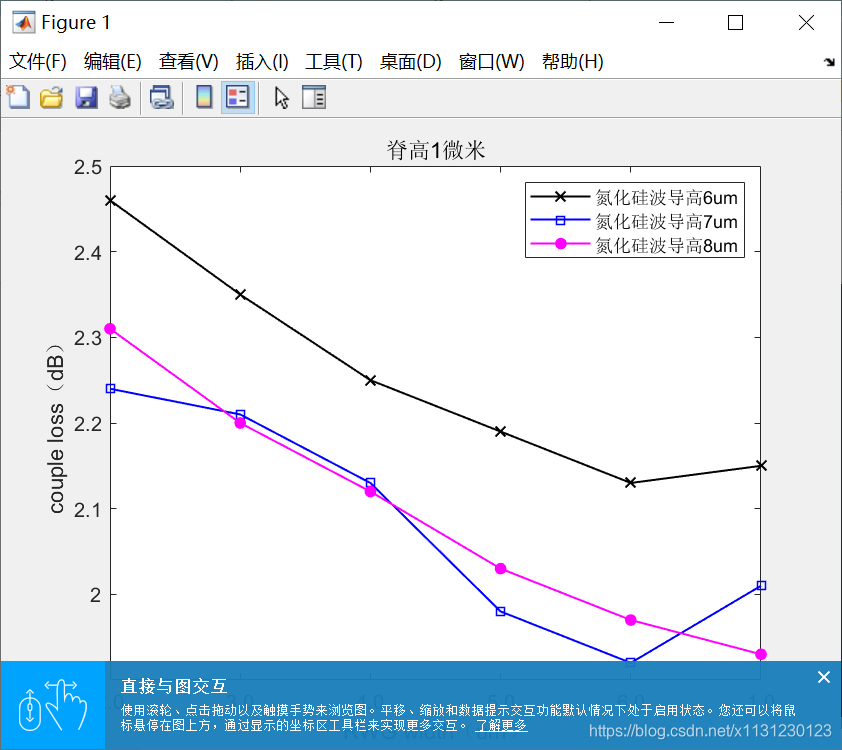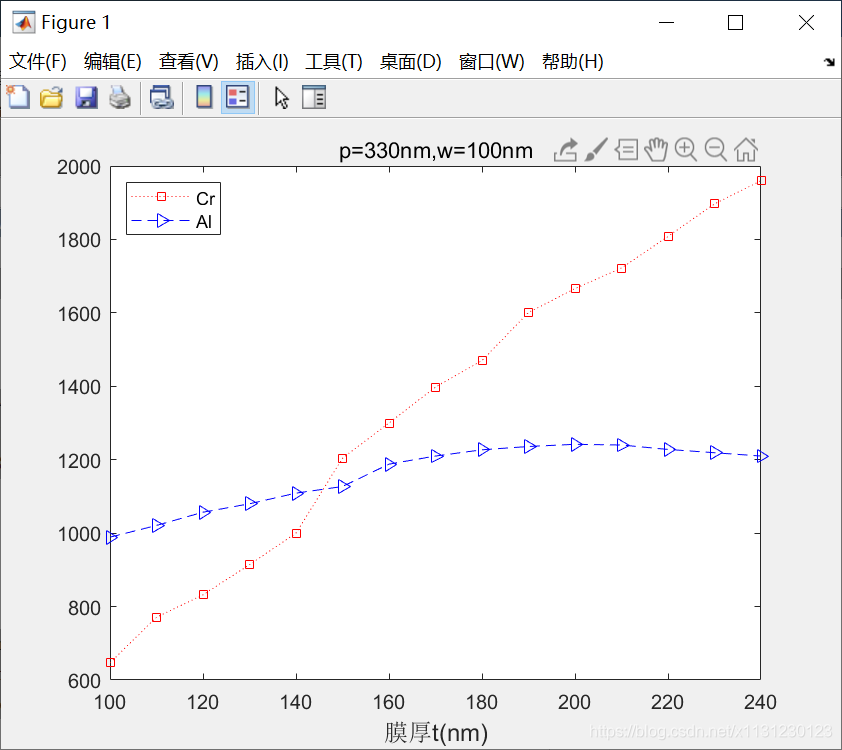MATLAB 实际的一些图 画图
目录
Matlab 数据可视化深入解析
在这篇博客中,我们将探讨如何使用Matlab进行有效的数据可视化,重点是如何展示数据的同时保持图表的美观和清晰。我们将通过几个示例,展示不同的数据集和可视化技术。
双坐标绘图
以下Matlab代码展示了如何创建一个双坐标图表,用于对比展示“耦合效率”和“耦合损耗”。这种图表非常适合同时展示两组数据的变化趋势,而这两组数据的量纲或数值范围差异较大。
python展开代码x = [0 100 300 600 1000 1500];
y1 = [68.1 66.7 61.7 44.68 28.4 17.2];
y2 = [1.67 1.76 2.1 3.5 5.6 7.7];
hold on;
[AX, H1, H2] = plotyy(x, y1, x, y2, @plot);
set(get(AX(1), 'ylabel'), 'String', '耦合效率(%)', 'FontSize', 16);
set(get(AX(2), 'ylabel'), 'String', '耦合损耗(dB)', 'FontSize', 16);
xlabel('X容差(um)', 'FontSize', 16);
set(H1, 'LineStyle', '--');
set(H2, 'LineStyle', ':');
set(gcf, 'Color', 'white')
set(gca, 'LineWidth', 1.5)

波导高度与耦合损失关系
在下一个例子中,我们将观察不同波导高度对耦合损失的影响。通过绘制三条不同高度的氮化硅波导的耦合损失,我们可以比较哪种设计更优。
python展开代码clc, clear;
x1 = [1, 2, 3, 4, 5, 6];
y1 = [2.46, 2.35, 2.25, 2.19, 2.13, 2.15];
h = plot(x1, y1, 'x-k', 'MarkerSize', 7, 'LineWidth', 1);
hold on;
x2 = [1, 2, 3, 4, 5, 6];
y2 = [2.24, 2.21, 2.13, 1.98, 1.92, 2.01];
plot(x2, y2, 's-b', 'LineWidth', 1);
x3 = [1, 2, 3, 4, 5, 6];
y3 = [2.31, 2.2, 2.12, 2.03, 1.97, 1.93];
plot(x3, y3, '.-m', 'MarkerSize', 20, 'LineWidth', 1);
legend("氮化硅波导高6um", "氮化硅波导高7um", "氮化硅波导高8um", "Location", "Northeast");
xlabel("RWG width(um)");
ylabel("Couple loss(dB)");
title("脊高1微米");
haxes = get(h, 'Parent');
set(haxes, 'XTick', (0:1:6), 'XTickLabel', ['1.0', '2.0', '3.0', '4.0', '5.0', '6.0']);

图例位置解析
Matlab中的图例位置参数对于图表的最终展示非常关键。正确的图例位置可以避免与图表数据的重叠,同时确保图表的整体美观。以下是Matlab中可选的图例位置参数,供你在绘制图表时参考使用。
c展开代码'North', 'South', 'East', 'West',
'NorthEast', 'NorthWest', 'SouthEast', 'SouthWest',
'NorthOutside', 'SouthOutside', 'EastOutside', 'WestOutside',
'NorthEastOutside', 'NorthWestOutside', 'SouthEastOutside', 'SouthWestOutside',
'Best', 'BestOutside'
金属薄膜的光学特性
在这个例子中,我们使用Matlab来分析不同金属薄膜在不同膜厚下的光学特性。这可以帮助材料科学家和光学工程师更好地理解材料在实际应用中的表现。
c展开代码clc, clear;
x = [100, 110, 120, 130, 140, 150, 160, 170, 180, 190, 200, 210, 220, 230, 240];
y1 = [647, 771, 832, 914, 1000, 1204, 1300, 1398, 1470, 1601, 1666, 1722, 1808, 1897, 1960];
y2 = [989, 1021, 1057, 1080, 1109, 1127, 1188, 1210, 1227, 1236, 1242, 1240, 1228, 1219, 1210];
plot(x, y1, ':rs');
hold on;
plot(x, y2, '--b>');
title("p=330nm, w=100nm");
xlabel('膜厚t(nm)', 'FontSize', 12);
legend("Cr", "Al", 'Location', 'NorthWest');

通过以上的示例和解析,我们可以看到,Matlab提供了强大的工具集,可以帮助我们从不同角度和深度分析数据。无论是科研还是工业应用,Matlab都是一个值得学习和掌握的工具。
如果对你有用的话,可以打赏哦
打赏


本文作者:Dong
本文链接:
版权声明:本博客所有文章除特别声明外,均采用 CC BY-NC。本作品采用《知识共享署名-非商业性使用 4.0 国际许可协议》进行许可。您可以在非商业用途下自由转载和修改,但必须注明出处并提供原作者链接。 许可协议。转载请注明出处!
目录